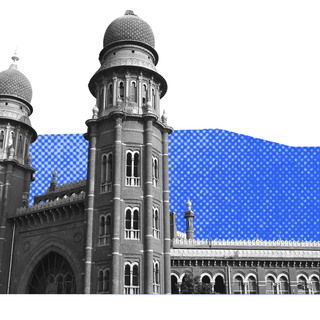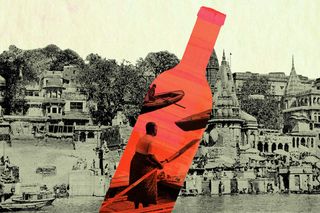
In Banaras, Casteism and an Alcoholism Epidemic Are Criminalizing the Local Mallah Community
Brahminism and colonialism have both played an important role in creating the stereotype of a ‘drunken mallah.’

The large caste community of Mallahs living by the Ganga has a very old problem of alcoholism. This is reinforced by societal stereotypes that have a history rooted in colonial society and are maintained by a bourgeois-centric class society in Banaras…
A few years ago, a small liquor store near the Bhaisasur ghat in Banaras was attacked by local women with bricks and stones. The women belong to the mallah caste, a community known across the region for the alcoholism of its men.
“The daaru theka had to be closed down for a few days… It is a common way they raise their voice against their drunk husbands,” says Babita Sahani, a Mallah woman who lives at Bhaisasur ghat. Many women and children from the allah community struggle with careless and violent husbands, who attempt to relax with excessive drinking after a long day of work.
“Consuming around 5-6 sheeshi (glass bottles) per day is too much. All the alcoholics consume it through the night, lying at the ghats without a care in the world for their family or money,” says Santosh Sahani, a navik at Munshi ghat. “We have seen this in our parents and our grandparents too. I too started like this, and it is common that our children start drinking too. What to do, our work is as such…”
Mallahs work as boatmen, gotakhors (divers), and as local guides at all the ghats of Banaras. They are considered to be highly reliable when it comes to any kind of information relating to the ghats and the culture of the Ganga, as their history has been connected to the region for generations.
However, they are stereotypically tied to alcohol and alcoholism, and people across Banaras claim that Mallahs are alcoholics. “We feel very sad when we hear this about our community from other people,” says Mallu Sahani. Mallu is a gotakhor, an occupation among allahs that involves diving down to the Ganga river bed to retrieve coins thrown into the river by pilgrims to make an earning. Often, a gotakhor‘s work also involves finding bodies of people who have drowned in the river to help the local police.
“See, we do this throughout the day. Again and again going into the river, taking deep breaths, and swimming. And many times carrying whole bodies up to the ghats. It’s all tiring work, and a gotakhor won’t go in without drinking first,” says Mallu.
Related on The Swaddle:
How ‘Faith Healing’ in Banaras Exploits People With Mental Illness
This is because alcohol helps numb the senses, which helps with the painstaking labor of the gotakhors. Among the community, alcohol is also believed to maintain body warmth in cold river water streams.
The gotakhors are a group that has always suffered from poverty and deprivation. Their occupation earns them a measly 200-300 rupees a day, making them more prone to alcohol addiction as compared to Navik-Mallahs, who run boats. Liver-related issues and kidney failure are common health problems facing the whole community, along with drunken driving incidents.
There is no state-sanctioned mechanism to pay the gotakhors for their labor of retrieving corpses from the Ganga. As a result, the gotakhors are often paid with alcohol, thus reinforcing the stereotype of alcoholism. “They give us two bottles sometimes and rarely any money. Many gotakhors are content with this,” says Mallu.
This attitude of labeling the allahs “drunkards” is greatly rooted in the colonial categorization of lower castes as “uneducated” and “depraved,” thus prone to alcoholism and criminality.
Writing about alcoholism among the Mallah community, scholar Assa Doron writes that Brahminism and colonialism have both played an important role in creating the stereotype of a “drunken Mallah.” While Brahminism condemned Mallahs as a lower caste for being a fishing community, colonial perceptions categorized them as a criminal caste and savages. “The reputation of the boatmen as prone to drunken and criminal behavior far predates the colonial encounter, but it was during the colonial regime that the Brahminical views of low castes as ritually polluted and unruly merged with the British notions of morality and utilitarianism.”
Mallah activity came under the strict colonial administration when in 1916, a licensing system for running boats in the Ganga was established. The aim of the licensing system was to assert “greater control over the riverscape. […] boatmen had to comply with certain rules and pay fixed annual fees to ply their boats in the city,” Doron notes.
The licensing system created clear guidelines “for the individual and collective behavior of boatmen” in the form of by-laws. Perceived notions of drunkenness, abusive or insulting behavior were prohibited and criminalized for at-work Mallahs in a manner that suited the economy that the British wanted to run. “[…] colonial views on alcohol were couched in a moral discourse and practical concerns extending to their own interests in India, as alcoholism and sexually transmitted diseases were among the primary causes of death among soldiers and officials from the early nineteenth century,” Doron notes.
The remnants of such attitudes towards the disease of alcoholism still haunt the community today. The colonial approach to policing them finds a sad parallel in the working of the navik union. “Before any meeting is called for by the union, we are given a warning that nobody should come drunk to the meeting,” says Bachha Manjhi, a navik-mazdoor. “But there is no effort by the union to help us get away from alcohol. Same is with the local government.”
Related on The Swaddle:
Companies are Rebranding Indigenous Liquors Like Mahua Into Desi Cocktails. Who Stands To Gain?
The Mallah community also associates the ritualistic use of alcohol with local gods. Offerings of khasi (male goat meat) and alcohol are common to dihs (local guardian gods), and often these are offered just before the gotakhors go for a dive to retrieve corpses. The offering of meat and alcohol is owing to the tamasic qualities (qualities relating to malevolent spirits and impurity) of these gods.
It is thus not far-fetched that these ritualistic practices then make their way into everyday culture, contributing to alcoholism.
However, it is not strictly caste reasons that lead to alcoholism in the Mallah caste. For instance, even though sattvic (related to purity, godliness) beliefs prohibit alcohol and meat in rituals as well as in daily life, the brahmin priests themselves drink at the ghats.
Alcoholism is also perpetuated by a classist society that favors certain “tastes” and “spaces,” which work in tandem with caste stereotypes to reproduce stereotypes.
Doron notes that the bourgeois upper-caste brahmins not connected to the ghats have a preference for high-end liquor and also have reservations about the spaces they drink in, preferring to drink at home. The difference between desi daaru (country liquor) and exported liquor is heavily dependent on taste and economic status. Country liquor is readily available, cheaper, and is a social lubricant of the masses that has multiple uses among the marginalized castes and working class.
In this context, Doron provides an excellent example illustrating the bourgeoisie’s relation to country liquor. “[…] one upper-class Brahmin did mention that a common practice within his biradri (community) was to use deshi daru for massage, as it is very potent and heats the muscles when rubbed into the skin and was ‘very good for lower back pain and inner bodily pain’.”
The task of massaging too is associated with the Dalit caste chamars, who act as masseurs for the upper-castes. Country liquor and its drinkers/users are relegated to a specific class and caste status that may change according to the needs of the bourgeoisie, as long as it remains tightly assigned to these class and caste positions. Alcohol preferences of the bourgeois are viewed as exceptionalism that contrasts with the Mallah’s social and material realities.
It is owing to these ideologies that the problem of alcoholism persists in the Mallah community. The Mallahs navigate this problem in many ways, often resisting it as the Mallah women do, or by trying to get their children to move away from the occupation of boat-riding and gotakhori. A one-dimensional view of the problem only stereotypes the people and reproduces the same environment that allows this social evil to thrive. It blames the Mallah for their own misery, while the state and a classist society work together with caste-based work culture to reproduce the conditions for this misery.
Kushal Choudhary is an independent journalist based in Banaras, exploring modernity and tradition through the lens of history and caste. Govind Sharma is an independent writer based in Varanasi exploring caste and social issues.
Related


Pope Francis Calls Domestic Violence ‘Almost Satanic’
